Portable power stations, also known as portable generators or battery packs, are becoming increasingly popular for travel and RV use, especially when conventional power sources are unavailable. They are also superior to gas-guzzling generators that generate unwelcome noise pollution and require propane or gasoline to run.
Portable power stations offer a dependable and practical supply of electricity to campers, overlanders, and outdoor enthusiasts who need to power electronics, appliances, and other equipment while off-the-grid or during blackouts, making them beneficial, if not essential.

One of the main advantages of a portable power station is its portability. They are relatively lightweight and compact, making them easy to take on the road, and can be easily stored and secured in an overland rig or RV.
Many portable power stations come with multiple outlets, USB ports, and, at times, built-in inverters, making them capable of powering multiple devices at once.
Another advantage of portable power stations is their versatility. We use our portable power station to power our computers, cellphones, tablets, cameras, and Starlink. When camping on a remote beach in Baja, California, we utilized the Wagan 1,200-watt power station to charge both our Starlink and laptop while charging the power station via solar panels, thereby saving us from an overcrowded campsite and the cost thereof.

We also utilized our Wagan 1200 portable power station for our blender when mixing cocktails and smoothies, as well as our hair trimming kit; the power station could also run a CPAP machine overnight for sleep apnea sufferers.
Most portable power stations can be charged via several power sources, such as solar panels, a USB car charger, a traditional outlet, or a car battery.
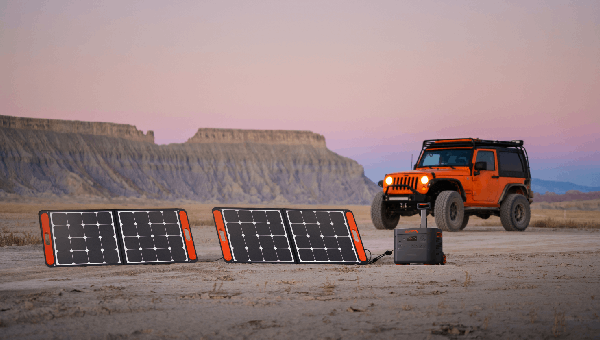
The following points are worth considering when purchasing a portable power station:
- Battery Capacity – The level of power is measured in watt-hours, and the higher the rating, the longer it lasts to power your devices;
- Output Ports – Most portable power stations have a few USB points, an AC and DC outlet, and an automobile auxiliary power outlet (cigarette lighter);
- Weight and Portability – You want to ensure that your portable power station is lightweight so that it is easily transported for ease of travel and also shaped as close to a square as possible;
- Charging Options – The ability to charge via solar, a standard household power outlet, or your USB car charger while driving;
- Safety of a Lithium-Powered Battery Unit – We can transport our portable power station at any configuration without risking the unit’s integrity. Likewise, a weather-resistant and robust unit that can withstand dust, water, and high impacts is vital when utilizing it outdoors;
- Ensure That the Unit Allows Pass-through Charging – The ability to charge a device while simultaneously charging your portable power station;
- Mobile App Integration – This will enable you to monitor the portable power station’s performance and state of charge.

When considering the purchase of a portable power station, you need to ascertain what you will be charging. A very simplified explanation of how to measure your power needs is as follows:
Watt-hours is a unit of measurement that represents the amount of energy stored in a battery and how much an electrical device consumes. For instance, a 100 amp-hour battery with a voltage of 12 volts would hold a capacity of 1,200 watt-hours (100 x 12 = 1,200). If my laptop utilizes 45 watts of power, a portable station with a 100 amp-hour battery can charge my laptop continuously for just over 26 hours (1,200 / 45 = 26.67).
If your portable power station has a state of charge (SOC) of 100 percent, the unit can retain this charge for up to a year, providing emergency backup power when needed.
Tip: The SOC on a portable power station determines the rate of charge, so keep your portable power station charged to 100 percent to maximize the charge time.
Here is a list of popular portable power stations currently available on the market, favored by RVers, overlanders, and campers:
LiPower Mars-1000 Pro


With an impressive battery capacity of 1,120 watt-hours and the fact that this power station can power up to 10 devices simultaneously, along with flow-through charging, the Mars-1000 is more than capable of satisfying your energy needs.
The casing is lightweight but robust, with rubberized feet to ensure it won’t slide around damaging any valuables while off-roading. Along with an easy-to-understand LCD that provides the SOC as well as input and output wattage (along with fault codes) and the ability to dual charge from both solar and AC power, this is a winner.

When off-grid, LiPower Apolle100 solar panels can be paired with the Mars-1000 portable power station; however, it must be noted that it has a 200-watt max solar input. With advanced safety features such as a thermal sensor and multiple internal fans, this portable power station will not charge any outlet with a ground-fault-circuit interrupter (GFCI) as the AC outlet from the power station is not connected to AC neutral.
Key features of the Mars-1000 include:
- Charging Options – Can be recharged using a 12-volt DC socket, solar panel, or AC home power and a generator
- Charging Ports – USB Type-C, USB Type-A Quick Charge, 2 x USB Type-A, and 3 x 110-volt AC sockets
- Included Accessories – 10-amp ACDC charger, DC cable extension with cigarette plug, and an Anderson connector
- Dimensions – Measures 12.6 (L) x 9.1 (W) x 10.02 (H) inches and weighs 29.3 pounds
- Operating Temperature Range – Within -10°C to 75°C.
$1,300 | lipower.com
EcoFlow Delta 2

When I read the specifications on this unit, I did a double-take; this portable power station is a real contender in the market. The Delta 2 has an initial capacity of 1 kilowatt-hour, providing ample energy to sustain your essentials for hours on end. It outperforms other power stations with 2,200 watt-hours, thanks to the integration of X-Boost and X-Stream technologies. X-Boost allows you to power appliances with higher power ratings than your portable power station by reducing the voltage and amperage of your appliance through a lower-rated inverter. X-Stream’s AC charger adjusts the watts and voltage to maximize the charge rate, thereby reducing charging time from 0 to 80 percent in 50 minutes.
The Delta 2 offers the flexibility to expand your battery capacity and can act as a reliable emergency power supply when you have grid blackouts at home with a simple plug-and-play to your home’s power inlet box. You also have the ability to charge up to 15 devices at one time.

The only drawback of this portable power station would be the carry handles that extend outward past the unit, which may create wasteful space when packing it in your rig.
If you’re looking for more capacity, the Delta 2 Max has just been released.
Key features of the EcoFlow Delta 2 include:
- Charging Options – Can be recharged using a 12-volt DC socket, solar panels, or AC home power
- Charging Ports – Two USB Type-C, two USB Type-A, two USB Type-A fast charge and six 110-volt AC sockets
- Included Accessories – AC charger, car charger cable, DC5521 to DC5525 cable
- Dimensions – Measures 15 (L) x 8.26 (W) x 11 (H) inches and weighs 27 pounds
- Operating Temperature Range – Within 0°C to 30°C
$1,000 | ecoflow.com
Dometic 40Ah Lithium Battery (PLB40)

The well-known Dometic Outdoor range should not be overlooked if you’re looking for a “lightweight” option on the lithium battery market. The 40-amp hour lithium iron phosphate (LiFePO4) battery may be small and weigh only 16 pounds, but it certainly packs a punch with fewer frills. This may be a better option for the weekender or short-term overlander when looking for a compact portable power station or for anyone not looking to hard-install a portable power station.
It is explicitly designed for Dometic’s CFX and other powered cooler ranges, and features a sleek and ergonomic design with a stainless steel carry handle. The simplified LCD screen provides you with the SOC and charging status. The only drawback (or win) would be that the 12-volt DC 2-pin output is used solely for their range of coolers and without mounting points for the battery. The Zamp Solar Obsidian Series 100-watt solar panel can be paired with the PLB40 portable power station.
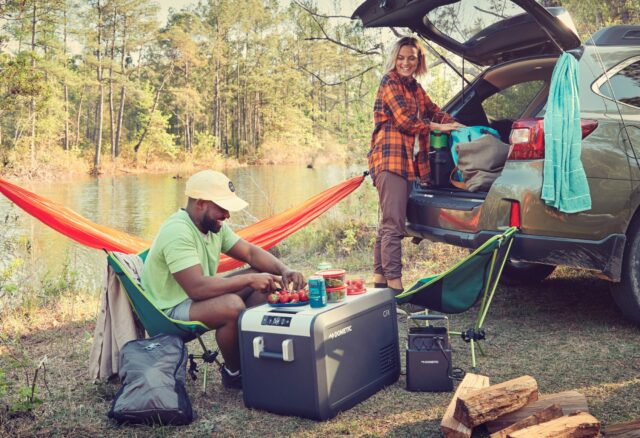
Key features of the Dometic PLB40 include:
- Charging Options – Can be recharged using a 12-volt DC socket, solar panel, or AC home power
- Charging Ports – Two USB Type-C, 12-volt 2-pin connection for portable fridges, 12-volt DC
- Included Accessories – 10-amp ACDC charger, DC cable extension with cigarette plug, and an Anderson connector
- Dimensions – Measures 7.76 (D) x 10.02 (H) x 7.76 (W) inches and weighs 16.1 pounds
- Operating Temperature Range – Within 0°C to 50°C
$850 | dometic.com
Jackery Explorer 1500 Pro Portable Power Station


Unleash your power requirements with the Jackery Explorer 1500 Pro. This portable powerhouse boasts 1,512 watt-hours of energy capacity, all neatly packed into a lightweight, fire and shock-resistant unit weighing only 37.4 pounds. The Explorer 1500 Pro is equipped with an intelligent battery management system (BMS) featuring 12 layers of protection, an exceptional electromagnetic interference (EMI) design, and an unparalleled cooling system, ensuring that you can carry this portable power station with its ergonomic folding handle without fear of potential hazardous damage.
The Explorer 1500 Pro guarantees years of dependable operation with a capacity retention rate of 70 percent after a remarkable 2,000 cycles. After about five years, it will still have 70 percent of its original capacity if you charge and discharge it twice a week. It can operate at full capacity in standby mode for more than 365 days and has a fantastic standby time of 472 days, even at 80 percent charge.

One issue I have is the charging time for portable power stations. Occasionally, I find myself in situations where I need to be on the move, and the slow charging time makes it challenging to rely on viable charging options. Still, the Explorer 1500 Pro has a remarkable 2-hour solar charge that supports up to 1,400 watts of solar power input (using six 200-watt solar panels), making planning for a full day of outings easier. Other notable features are the intuitive smart screen, a max sound output of 45 decibels (equivalent to your fridge), and the three-year warranty.
Key features of the Jackery Explorer 1500 Pro include:
- Charging Options – Can be recharged using a 12-volt DC socket, solar panels, or AC home power
- Charging Ports – Two USB-Type A ports, two USB-Type C ports, three AC outputs and car charger
- Included Accessories – AC charger, DC7909 to DC8020 adaptor, DC cable extension with cigarette plug
- Dimensions – Measures 15.12 (L) x 10.59 (W) x 12.11 (H) inches and weighs 37.4 pounds
- Operating Temperature Range – Within -10°C to 40°C
$ 1,700 | jackery.com
Wagan Lithium Cube 1200

After rigorous field testing over the past two years from the Arctic Circle to Guatemala in a Range Rover Classic and the Nimbl Camper, the Wagan 1200 impressed us with its remarkable compact and lightweight design and outstanding durability. With a robust 1,166-watt-hour, lithium-ion battery, it comes equipped with a reliable 1,000-watt power inverter, ensuring that your AC appliances receive a steady supply of Pure Sine Wave energy. Pass-through charging allows simultaneous use and charging, enabling you to draw power and charge from multiple sources concurrently. The integrated 100-watt MPPT solar charge controller draws 15 to 30 percent more power from your solar panels, drastically reducing recharge times. Both the 68-watt foldable solar panel and 100-watt solar panel come equipped with Anderson Power Pole connectors for easy plug-and-play.
The Wagan 1200 is lightweight at 24.5 pounds and can be stored in any orientation, whether vertically, horizontally, or even upside down (although not generally recommended for long periods), and the flatpack handle and nearly square shape makes it ideal for tight spaces.
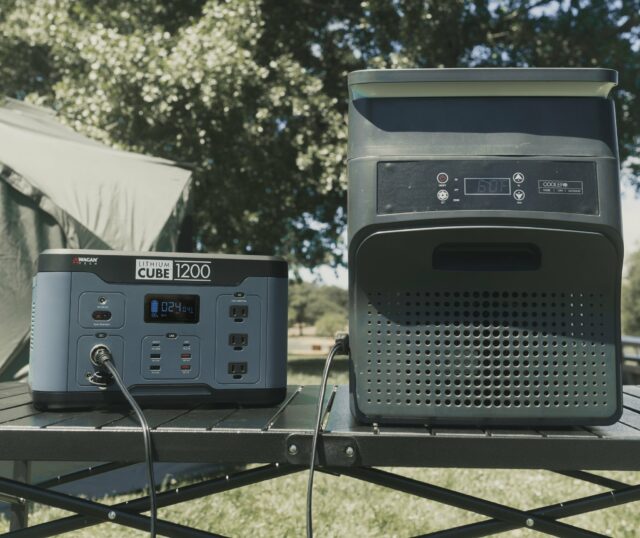
We’ve tested the Wagan 1200 power station in extreme conditions, from the scorching 40°C heat and humidity of the Guatemalan jungles to the bone-chilling Arctic cold at -45°C, and it has performed flawlessly throughout.
Key features of the Wagan Lithium Cube 1200 include:
- Charging Options – Can be recharged using a 12-volt DC socket, solar panels, wind turbine, hydroelectric, or AC home power
- Charging Ports – Two USB-Type A ports, two USB-Type C ports, two USB-Type QC ports, three AC outputs, two 12-volt DC outputs, and a 12-volt DC car charger socket
- Included Accessories – AC charger, DC cable extension with cigarette plug
- Dimensions – Measures 13.4 (L) x 9.3 (W) x 8.3 (H) inches and weighs 24.5 pounds
- Operating Temperature Range – Within 0°C to 45°C
$ 1,250 | wagan.com
Renogy Portable Power Station 1000

The robust and reliable Renogy Power Station 1000 is a game-changer in portable power. It is constructed with Steel Grade Cold Rolled Commercial (SGCC) steel for certified impact resistance while incorporating dual fans, which ensures efficient cooling that outpaces conventional units by reducing thermal stress a staggering 180 times faster.
The company claims that due to ground-breaking iTurbo technology, when charging with AC power, the Renogy 1000 can charge from 0 to 80 percent in under one hour, which would be incredible. The power station’s AC output can be doubled to 2,700 watts, with a 1,997-watt-hour capacity, by enabling parallel connections (as an additional purchase). Due to its powerful 2,100-watt output capability, you can run up to 12 devices off the power station.

The Renogy Power Station 1000 also features an advanced BMS, which protects against reverse polarity, high/low temperature, short circuits, undervoltage, overvoltage, and overcurrent. It also has an automatic Standby Power Supply (SPS) mode, which switches between the power source and the portable power station, ensuring no loss of power to your devices.
The Renogy 1000 DC Home app tracks real-time power status, controls ambient lighting, sets auto-off timers, and adjusts recharging speeds. The drawbacks of this portable power station would be the shape and a hefty weight of 41 pounds.
Key features of the Renogy 1000 include:
- Charging Options – Can be recharged using a 12-volt DC socket, solar panels or AC home power
- Charging Ports – Two USB-Type A ports, one USB-Type A fast charging port, two USB-Type C ports, six AC output, and a 12-volt DC car charger socket
- Included Accessories – AC charger, DC car charger, and solar charge cable
- Dimensions – Measures 18.27 (L) x 10.79 (W) x 11.57 (H) inches and weighs 41 pounds
- Operating Temperature Range – Within 0°C to 40°C
$1,250 | renogy.com
Bluetti AC60 Portable Power Station

The Bluetti AC60 is a compact but seemingly remarkable portable power station that stands out in the lightweight division by delivering an impressive 1,200-watt maximum through its 600-watt inverter. This power capability enables you to efficiently run high-wattage resistive appliances like hair dryers and grills.
This portable power station incorporates an intelligent BMS, an efficient MPPT controller, and powerlifting technology with the option to expand the battery capacity from 403 to 2,015 watt-hours. It recharges from AC power to 100 percent in one hour. A minor bonus feature of the Bluetti AC60 is the wireless charging pad on the top of the portable power station.

The Bluetti AC60 is built with aluminum alloy casing with waterproof rubber that isolates circuits from fan vents and seals all outlets, safeguarding against water and dust infiltration. If in doubt, the company offers an ultra-long warranty of six years.
Key features of the Bluetti AC60 include:
- Charging Options – Can be recharged using a 12-volt DC socket, solar panels AC home power, or lead-acid battery charging
- Charging Ports – Two USB-Type A ports, one USB-Type C port, two AC outputs, and a 12-volt DC car charger socket and wireless charging pad
- Included Accessories – AC charger, DC car charger, and solar charge cable
- Dimensions – Measures 11.42 (L) x 8.07 (W) x 9.21 (H) inches and weighs 20 pounds
- Operating Temperature Range – Within 0°C to 40°C
$700 | bluettipower.com
Anker Solix F2000


In the world of portable power stations, one standout model comes equipped with a massive 2,048-watt-hour capacity and an impressive 2,400-watt AC output. A remarkable feature of the Solix F2000 is its ability to handle high-demand devices, supporting a staggering power output of up to 3,600 watts. This means you can run appliances like microwaves, coffee makers, and hairdryers without worrying about overloading the system. When it comes to recharging, this power station shines with a maximum solar input of 1,000 watts.
Transporting this power station should be a breeze due to its 4.72-inch wheels on an extendable pull handle, ensuring no strenuous lifting. The portable power station is impact-resistant, drop-proof, anti-UV, and flame-retardant, designed to be rugged enough to withstand the most challenging outdoor adventures. Its intelligent features include automatically shutting off output ports once a device is fully charged and shutting down the AC output when not in use.

Key features of the Anker Solix F2000 include:
- Charging Options – Can be recharged using solar panels or AC home power
- Charging Ports – Two USB-Type A ports, three USB-Type C ports, four AC output, TT-30R outlet, and two 12-volt DC car charger socket
- Included Accessories – AC charger, DC car charger, solar charge cable and accessories bag
- Dimensions – Measures 20.07 (L) x 9.8 (W) x 15.5 (H) inches and weighs 67 pounds
- Operating Temperature Range – Within -20°C to 32°C
$2,000 | anker.com
Runhood Rallye 1200 Plus

Runhood Rallye 1200 Plus is a lightweight, versatile, and compact modular portable power solution with swappable hot battery packs. This unique portable power station allows you to swap out the lithium-ion batteries on the go without losing power. Your purchase includes four battery packs/energy bars. You can charge two of these batteries independently while using the portable power station, leaving the remaining two batteries available for use.
The Rallye 1200 Plus portable power solution has a 1,296-watt-hour capacity and a peak power output of 2,400 watts and 1,200 watts AC power. The built-in pure sine wave inverter can safely power nine essential appliances, ensuring clean and stable energy for sensitive electronics. Bonus features include an LED light on the side of the portable power station with three settings and a wireless charging pad on the top for your devices.

An additional purchase of a DC Engine that clips onto the battery pack allows you to utilize it as an individual energy bar with two USB-Type C ports and two USB-Type A ports.
Key features of the Rallye 1200 Plus include:
- Charging Options – Can be recharged using a DC car charger, solar panels, or AC home power
- Charging Ports – Two USB-Type A ports, two USB-Type C ports, three AC outputs, and a 12-volt DC car charger socket
- Included Accessories – AC charger, DC car charger, solar charge cable, and four rechargeable interchangeable power packs
- Dimensions – Measures 13 (L) x 6.8 (W) x 8.8 (H) inches and weighs 10.8 pounds
- Operating Temperature Range – Within 0°C to 40°C
$1,300 | runhoodpower.com
Yoshino B4000 SST



The Yoshino B4000 is a game-changing solid-state portable power station with a 4,000-watt output and 2.6 kilowatt-hour capacity, reimagining portable energy options. With this large capacity, you can charge and power various devices and appliances with its pure sine wave inverter. Yoshino claims an energy density up to 2.5 times higher than its conventional lithium-ion predecessors, enabling a more streamlined and lightweight design. The solid-state battery technology also significantly reduces the risk of flammability and overheating.
The Yoshino B4000 is a sleek power station with an ergonomic design and soft-grip handles, making it easier to carry and transport. It comes equipped with a TT-30R outlet and pass-through charging capability. The Yoshino B4000 incorporates a range of protective features such as overcharge, over-discharge, and short-circuit protection, along with temperature control. Bonus features on the Yoshino B4000 include a TT-30R camper outlet, which is ideal for RVers and campers with off-grid power use (with circuit breaker), two wireless charges for your devices, a Yoshino app for remote use as well as Smart Link tech for infinite capacity expansion.

The only drawback of this device is its very hefty price tag and sizeable weight.
Key features of the B4000 SST include:
- Charging Options – Can be recharged using a DC car charger, solar panels, or AC home power
- Charging Ports – Two USB-Type A ports, two USB-Type C ports, two AC outputs, two 12-volt DC ports, two wireless charging pads
- Included Accessories – AC charger, DC car charger, solar charge cable, and DC5521 to cigarette charger
- Dimensions – Measures 21 (L) x 10.2 (W) x 9.4 (H) inches and weighs 53.6 pounds
- Operating Temperature Range – Within 0°C to 40°C
$3,300 | yoshinopower.com
ElecHive 2500
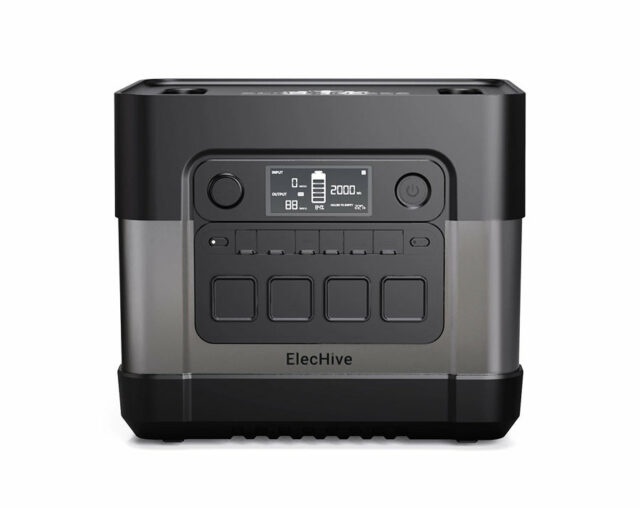

Zerobreeze has recently introduced the ElecHive 2500 portable power station. The ElecHive is powered by NMC batteries (lithium-ion battery that uses a combination of Nickel, Manganese, and Cobalt = liquid electrolyte) that produce 2,200 watts of power with a capacity of 2,500 watt-hours.
The ElecHive features 12 and 24-volt Anderson output interfaces and a built-in battery management system and boasts impact resistance, drop-proof durability, UV protection, and flame retardancy. The ElecHive features an auto-sleep mode and the option to charge and discharge the unit by either 90 or 100 percent by the switch of a button, thereby increasing the battery lifespan. We especially enjoy the fact that it has built-in handles, making it more ergonomic, and has waterproof caps on every port, ensuring no water or dust ingress. The ElecHive portable power station can be utilized alongside the Zerobreeze air conditioning unit efficiently.
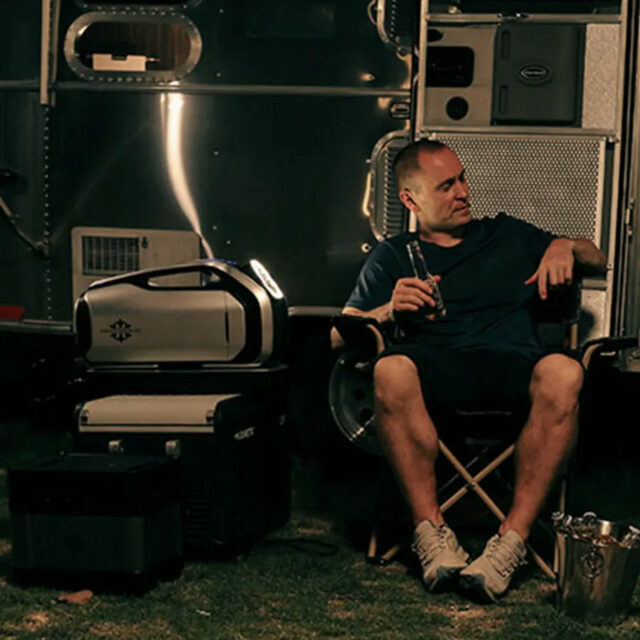
The company claims that the ElecHive can last up to 2,300 cycles while maintaining 80% health as long as the unit is charged every three days.
Key features of the ElecHive 2500 include:
- Charging Options – Can only be recharged using a 24-volt Anderson port via car charger, AC home power and solar power
- Charging Ports –One USB Type-C, one USB Type-C bi-directional full PD, two USB Type-A, four AC sockets, 12-volt Anderson port, 12-volt DC5221 port
- Included Accessories – 240-watt AC charger, 12-volt DC charger with cigarette plug, and 12-volt outlet adapter, all with Anderson connectors
- Dimensions – Measures 12.9 (L) x 9.6 (W) x 11.3 (H) inches and weighs 40 pounds
$2,200 | zerobreeze.com
Read more: Buyers Guide :: Portable Shower Solutions for Overland Travel
Our No Compromise Clause: We do not accept advertorial content or allow advertising to influence our coverage, and our contributors are guaranteed editorial independence. Overland International may earn a small commission from affiliate links included in this article. We appreciate your support.


